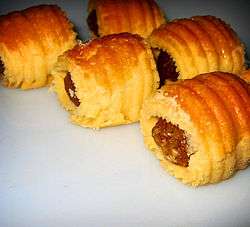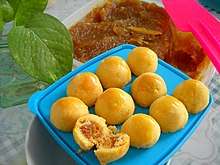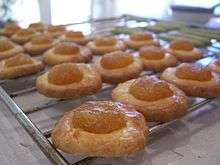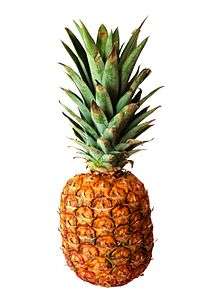Pineapple tart
Pineapple tarts or nanas tart are small, bite-size pastries filled or topped with pineapple jam, commonly found throughout different parts of Southeast Asia such as Indonesia (nastar),[5] Malaysia (Baba Malay: kueh tae / Kuih tair,[6] Malay language: kuih tat nanas), Brunei and Singapore in various forms.[5] The origins of the pineapple tart possibly derives from a Portuguese influence[1][2] back in the 16th century when the pineapple, a fruit native to South America, was introduced by the Portuguese Empire to Asia, specifically the Malay Peninsula.[3][4] A similar influenced pastry, known as pineapple cake or pineapple pastry, is also found in Taiwan, South Korea and Japan.
 Pineapple tarts in the shape of rolls open at the ends and filled with jam | |
| Alternative names | Nastar, Tat Nanas, Kueh Tae, Kue Nanas |
|---|---|
| Course | Dessert |
| Place of origin | Possibly Portugal[1][2][3][4] |
| Region or state | Asia |
| Associated national cuisine | Indonesia, Malaysia, Singapore, Brunei |
| Main ingredients | Pastry (butter, egg yolk, corn starch), pineapple jam |
General description
The pastry consists of a large proportion of butter and egg yolk, besides using corn starch, giving it a rich, buttery, tender and melt-in-the-mouth texture. The pineapple jam is usually made by slowly reducing and caramelizing grated fresh pineapple that has been mixed with sugar and spices - usually cinnamon, star anise and cloves.
Typical shapes include a flat, open tart topped with pineapple jam under a lattice of pastry, rolls filled with jam that are open at the ends, and jam-filled spheres or elongated shape.[7]
Regions
Indonesia

In Indonesia it is called nastar which is contraction of nanas tart (Ananas or pineapple tart), is a popular cookie or kue kering during festive occasions of Lebaran, Natal and Imlek. Just like many of Indonesian kue kering (cookies), it can trace its origin to Dutch influence on Indonesian pastry, cake and cookies tradition.[8]
Most of nastar in Indonesia has round shape with a diameter of about 2 centimetres. The pineapple jam is filled inside instead of spread on top. The cookie is often decorated with small pieces of cloves or raisins on top of it.[8]
Malaysia and Singapore

Considered a "festive cookie", pineapple tarts are especially popular during Hari Raya, Chinese New Year and Deepavali celebrations in Singapore and Malaysia.[9] They are also sold all year round by commercial bakeries and souvenir stores serving tourists.
Taiwan
The Taiwanese version of pineapple tart is known as fènglísū (鳳梨酥).[10] The filling is fully enclosed within a rectangular tart. Generally the taste is sweet due to sugar added. However, many bakers add or even substitute pineapple with winter melon to make the jam less tart as well giving a less fibrous texture to the filling.
Australia
In Australia the term often refers to a variation on the Neenish Tart, with pineapple jam below the filling, and passionfruit icing.
See also
- Kue
- Putri salju
References
- Andrea Nguyen (2011). Asian Dumplings: Mastering Gyoza, Spring Rolls, Samosas, and More. Potter/Ten Speed/Harmony/Rodale. p. 195. ISBN 16-077-4092-3.
- Terry Tan & Christopher Tan (2012). "David Thompson". Singapore Cooking: Fabulous Recipes from Asia's Food Capital. Tuttle Publishing. ISBN 14-629-0530-7.
- "Pineapple Tarts: A Piece Of Tropical Singapore". Michelin Guide Digital-Singapore. 7 February 2018. Retrieved 2020-04-24.
- Grace Teo (24 January 2016). "Nyonya Pineapple Tarts". Nyonya Cooking. Retrieved 2020-04-27.
- "Nastar cookies (Indonesian pineapple tarts)". Chef in disguise. 2017-04-13. Retrieved 2018-07-04.
- Lee Khang Yi (22 July 2018). "Symbolism and traditions rule at a Peranakan wedding feast". Malay Mail. Retrieved 2020-04-24.
- Teh, Lydia (7 November 2018). "Honk! if you're Malaysian". MPH Group Pub. – via Google Books.
- "Indonesian Pineapple Cookies (Kue Nastar)". Ketty's Cooking. 2014-05-09. Retrieved 2018-07-04.
- Osborne, Christine (7 November 1989). Southeast Asian Food and Drink. Bookwright Press – via Internet Archive.
Pineapple tarts malaysia.
- Hong Dam-young (7 July 2017). "[Weekender] Taiwanese desserts gain ground in Korea". The Korean Herald. Retrieved 2020-05-02.
